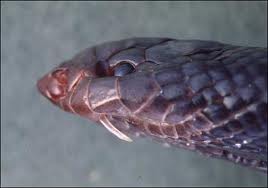 |
| Atractaspis duerdeni |
I've always thought that the atractaspids were a highly interesting group of snakes, deserving of an article or two. During the early stages of my cursory research, however, I found that palaeozoologist Darren Naish, author of the excellent blog Tetrapod Zoology, has already written an article containing what one commenter called "the most comprehensive information on Atractaspids anywhere on the web." Since I didn't think I could top that, I decided to focus on what we've learned about atractaspids since Darren's article came out in 2008. If you want to learn more about the many fascinating adaptations atractaspids have evolved for burrowing and closed-mouth fang-stabbing, including why they're known as والد من سواد ('father of blackness'), among other such macabre names, in Arabic-speaking countries in their native range, you'll want to read that article in addition to this one.
The correct placement of the atractaspids within the snake tree of life has been elusive since their initial description in 1843, when they were placed in the Elapidae alongside cobras and coralsnakes. In later classifications, they have been placed in the Viperidae, the Colubridae, the Lamprophiidae, or in their own family, to which various names have been applied, including Atractaspidae (atractaspids), Atractaspididae (atractaspidids, because why not add in an extra 'id'?), and Atractaspidinae (atractaspidines; this last name referring to a subfamily rather than a family). Once considered to include a wider diversity of snakes, the Atractaspidinae is now comprised of just two genera, the proteroglyphous Homoroselaps (2 species, known as Harlequin Snakes) and the eponymous, solenoglyphous Atractaspis (21 species). Aglyphous and opisthoglyphous snakes formerly included in this group are now assigned to a closely related subfamily, the Aparallactinae, which includes 50 species in nine genera, several of which are deserving of their own articles. This taxonomy is based on part of a larger analysis of advanced snakes undertaken by Alex Pyron and colleagues and published in 2010, and hinted at in earlier analyses such as this one by Kraus & Brown.
 |
| Part of the tree presented in Pyron et al. 2010, showing the relationships of atractaspids to other African snakes now placed in the Lamprophiidae. A surprising finding of this paper was that lamprophiids share a common ancestor with the front-fanged elapids, including cobras, sea snakes, and coral snakes, about 44 million years ago. |
 |
| No one is quite sure why, but some Atractaspis also possess extremely elongate venom glands, such as those seen here in a dissected A. fallax. |
 |
| Atractaspis engaddensis |
ACKNOWLEDGMENTS
Thanks to Michael & Patricia Fogden and Donald Schultz for photographs.
REFERENCES
Abd-Elsalam M, 2011. Bosentan, a selective and more potent antagonist for Atractaspis envenomation than the specific antivenom. Toxicon 57:861-870.
Bourgeois M, 1961. Atractaspis – a misfit among the Viperidae? News Bulletin of the Zoological Society of South Africa 3:29.
Deufel A, Cundall D, 2003. Feeding in Atractaspis (Serpentes: Atractaspididae): a study in conflicting functional constraints. Zoology 106:43-61.
Greene HW, 1997. Snakes: The Evolution of Mystery in Nature. Berkeley: University of California Press.
Ismail M, Al-Ahaidib M, Abdoon N, Abd-Elsalam M, 2007. Preparation of a novel antivenom against Atractaspis and Walterinnesia venoms. Toxicon 49:8-18.
Moyer K, Jackson K, 2011. Phylogenetic relationships among the Stiletto Snakes (genus Atractaspis) based on external morphology. African Journal of Herpetology 60:30-46.
Naish D, 2008. Side-stabbing stiletto snakes. Tetrapod Zoology.
<http://scienceblogs.com/tetrapodzoology/2008/05/26/sidestabbing-stiletto-snakes/>
Pyron RA, Burbrink FT, Colli GR, de Oca ANM, Vitt LJ, Kuczynski CA, Wiens JJ, 2010. The phylogeny of advanced snakes (Colubroidea), with discovery of a new subfamily and comparison of support methods for likelihood trees. Mol Phylogenet Evol 58:329-342.